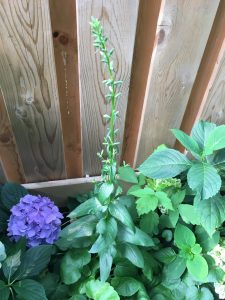
Is this poison ivy in my garden bed? Is the tall flower in between the Hydrangea a weed?
Thanks
Looking at your photograph, I am quite certain that what you have growing is not poison ivy but Creeping bellflower, Campanula rapunculoides L. As someone who works in gardens daily, I can tell you I see this plant quite a bit and it is a thug. It is a plant that will grow at the expense of others, so I would highly recommend that you remove this and be thorough.
To remove creeping bell flower entirely, you will most likely have to do it several times. The root system is persistent and unless you get the entire root, including all its small offshoots, it will reappear. The main root looks like a white fleshy tuber- almost like a parsnip. You will have to dig this out along with the smaller thread like white roots that accompany it. From what I can see in your photo, it appears that your plant bloomed and has gone to seed. This will mean that you will most likely have to work on the removal next year as well since this plant seeds itself very easily.
After removing it, I would recommend mulching thickly in this area. Your hydrangea will appreciate this as well, although make sure you do not mulch up against its woody stem, but about an inch away as this can rot it.
For you information, I found the following description of poison ivy on the Health Canada website:
“The leaves of poison ivy have three pointed leaflets. The middle leaflet has a much longer stalk than the two side ones. The leaflet edges can be smooth or toothed, but are rarely lobed. The leaves vary greatly in size, from 8 to 55 mm in length. They are reddish when they appear in the spring, turn green during the summer, and become various shades of yellow, orange, or red in the fall.
The plant stems are woody and of two kinds. The most common kind grows as a trailing vine, with upright leafy stalks 10 to 80 cm (4 to 31.5 inches) high. The second kind is an aerial vine that may climb from 6 to 10 m (6.5 to 11 yards) high on trees, posts, or rough surfaces.
The plant produces clusters of cream to yellow-green flowers during the months of June and July. The berries that appear by September are clustered, round, waxy, and green to yellow in colour. The size of the berries ranges from 3 to 7 mm (.12 to .28 inches) in diameter, and they often remain on the low, leafless stems of the plant all winter.”
Good luck removing your creeping bell flower!

